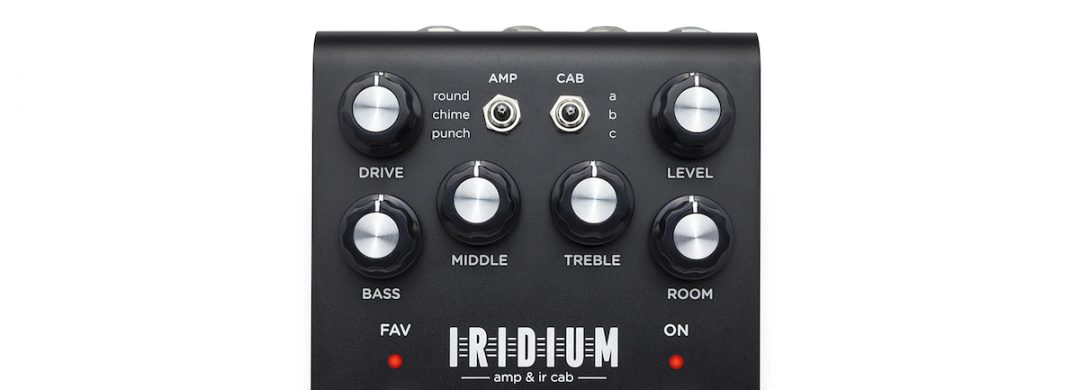Strymon has been making top-quality pedals in California since 2009. Many guitarists know them by their acclaimed reverb and delay units—the Big Sky and Time Line, respectively—which effectively raised the bar for time-based effect pedals. Last year, Strymon entered the amp and cab sim arena. In this Strymon Iridium review, we’ll cover the workings of what could be another modern classic Strymon design.
Strymon Iridium: An Amplifier in a Pedal
Let’s consider the average working guitar player for a moment; even though live music is still mostly on hold, it’ll be back one of these days! The sheer inconvenience of lugging a tube head and cabinet around is a very real struggle. Cost alone is a prohibitive thing for many artists gigging overseas and having to pay astronomical fees at the airport to fly with their rig. Plus, amp and effect modeling has never been better. This has plenty of guitarists opting for the portability (and versatility) of digital preamps and effects simulators like the Fractal Axe-FX, Neural DSP Quad Cortex, Line 6 Helix, and more.
These units contain hundreds of amps and effect models, practically limitless patch possibilities, and an endless array of tone. Most of the best tube amps are sort of one-trick ponies. The only way to expand your sound requires a bunch of expensive pedals. Modelers are portable, versatile, and ultimately cheaper than any amp/pedal arrangement.
Now, there’s even a demand for streamlining and shrinking down the average modeler into a pedalboard friendly package. The Strymon Iridium delivers on all fronts!
Strymon Iridium Review| Features
The Iridium is an amp and cabinet simulator in a pedal. Strymon’s patented Matrix Modeling technology took three of the most used amplifiers of all time and put them in a stomp box for the road, the studio, and at home. Each amp model also comes with its own trio of cabinet simulations that pair well.
The Round setting is based on a Fender Deluxe Reverb, while the Chime setting is based on a Vox AC30. Finally, there’s the Punch setting modeling a classic Marshall Plexi—plus, there’s a bit of extra gain on tap inside to push the Punch channel into high-gain territory for hard rock and metal.
Of the 9 impulse responses, you’ll find staples like a Mesa 4×12, a 2×12 with Celestion Vintage 30s, a basketweave Marshall, and more. You can also load your own third-party IRs using Strymon’s Impulse Manager software.
Controls
As far as controls go, they’re pretty similar to a regular amplifier. There’s a Drive and Level control, plus a standard 3-band EQ. Strymon kept the Iridium fairly stripped down without many fancy features, but the pedal is, of course, designed to play well with the rest of your pedals for things like modulation, overdrive, or any other effects you may have. There is, however, a Room control that allows you to add a bit of natural ambience to the signal.
I/O
On the backside of the pedal you’ll find a 1/4″ input for your guitar, stereo 1/4″ outputs, a USB connection for plugging the Iridium into your computer for IR loading, and an EXP/MIDI jack for expression pedals or to control presets and parameters via MIDI. If you pair this pedal with Strymon’s MultiSwitch Plus, you’ll be able to quickly switch between three user presets, and access up to 300 more through MIDI. On the front, you’ll find a headphone output for silent practice or to monitor while recording.
In Use
Tube amp dynamics are one of the hardest things to get right with any sort of digital modeling. Many guitar players will tell you there’s an undeniable ‘feel’ of a tube amp that just never quite translates to a model. Personally, I find modeled clean tones to feel pretty natural, but there’s some sort of disconnect with high-gain amp simulations. They just don’t respond to your playing the same way a real amp does.
That said, Strymon diligently recreated tube amp responsiveness, and they did an excellent job. Whether you roll back on your guitar’s volume, play more gently, or hit it hard, the amp (er, pedal) responds how a a tube head should.
The amps themselves sound quite nice and should be considered accurate emulations of their real-world counterparts. The Iridium runs the risk of sounding really dry and isolated, though the included Room function recreates the experience of playing an amp/cab in a space. Iridium’s sound can really be compared to what you’d hear in the control room of a studio when your cabinet is miked in another room. It’s dry and direct—almost sterile. But the onboard reverb does help liven things up.
Conclusion
Overall, the Strymon Iridium is easy to use and delivers great tones almost immediately. There’s really no fuss with this thing, which is great.
As an alternative to modelers like the Axe-FX or newer Quad Cortex, the Strymon Iridium is a perfect choice. It’s obviously aimed at users who don’t need 100+ amps and effects but still want excellent tones—all with the option to throw it in a backpack or keep it on a pedalboard for an amp-free experience.
You’ll also find the barrier of entry is a low $399, which you certainly won’t get with the bigger modelers out there.
